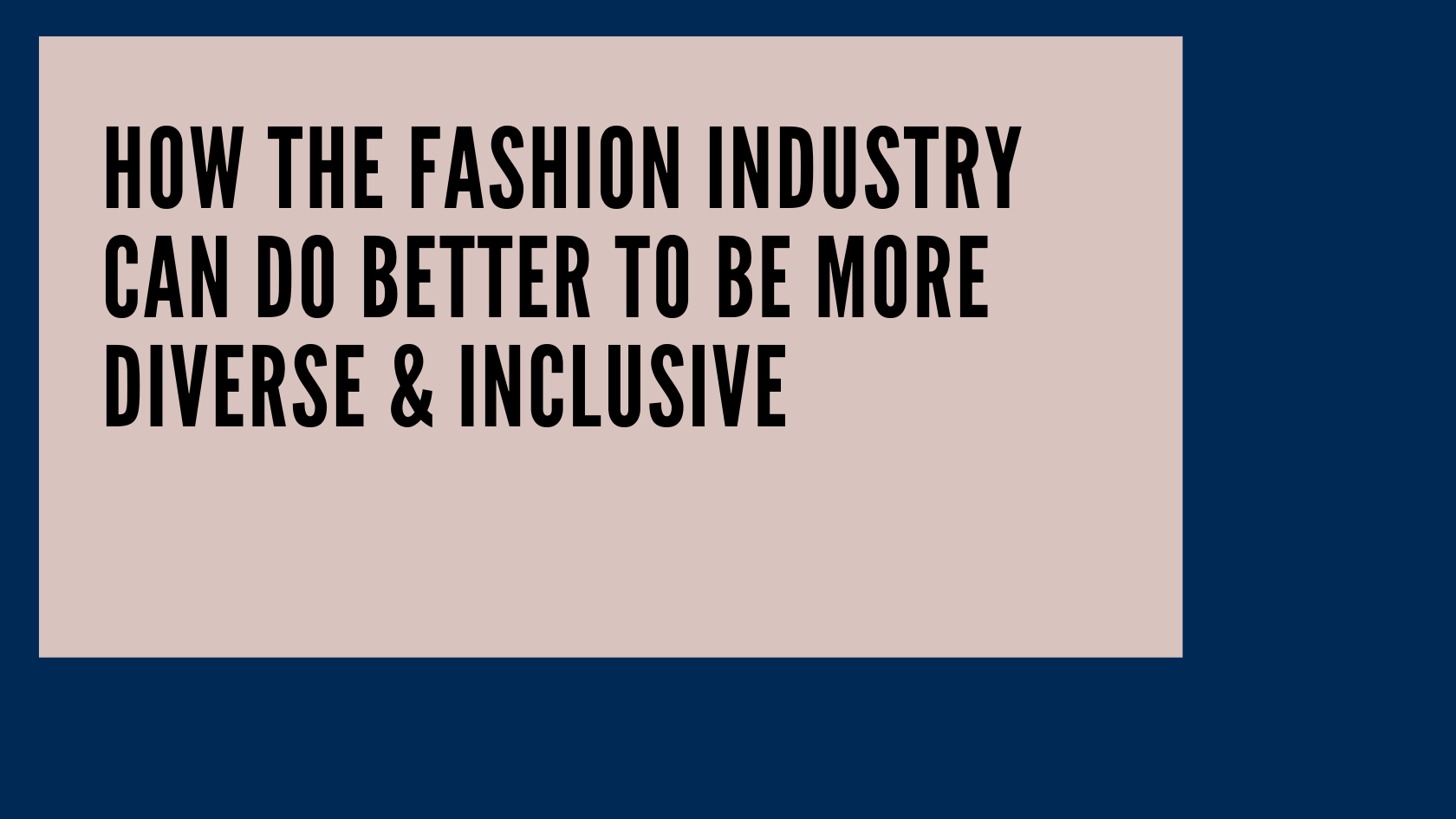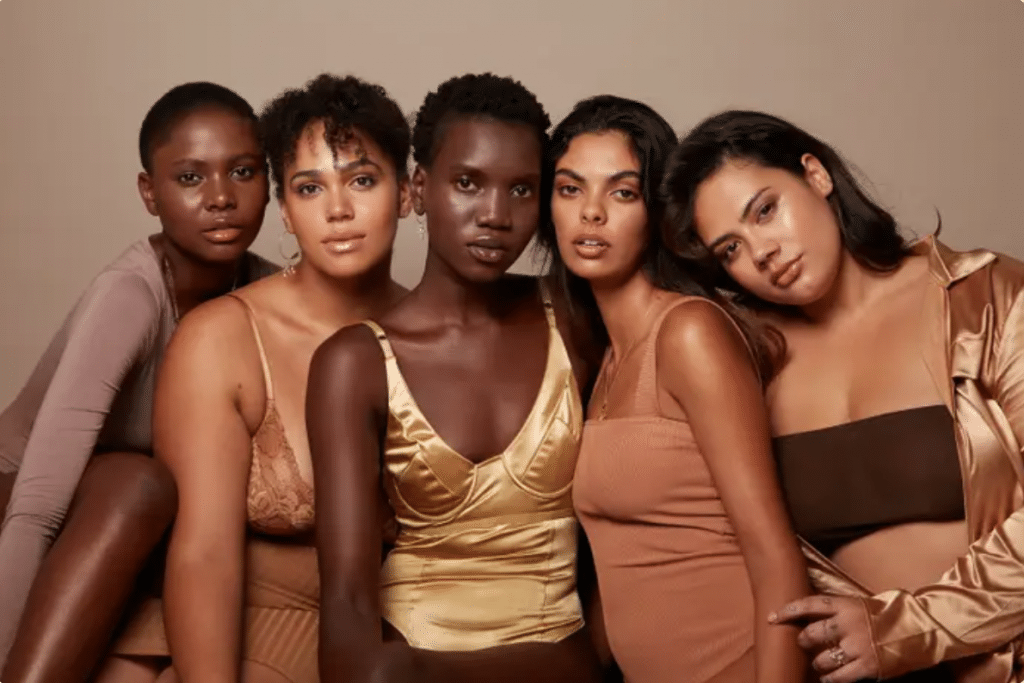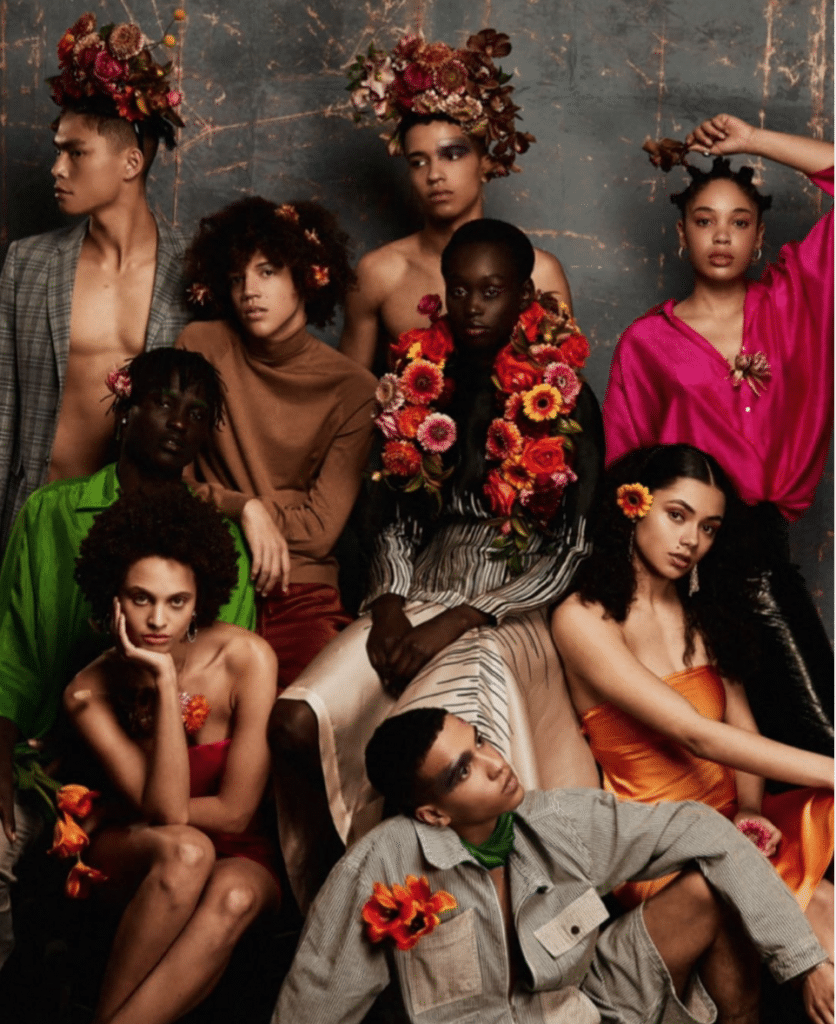The world is a diverse place so in an industry that impacts all whether it be from those watching the seasonal runways to seeing a large scale magazine or TV campaigns, scrolling through Instagram or to even smaller budget scale viewing like the weekly Target mail drop, it logically makes sense that representation in the fashion industry should be diverse too. And yet while we have seen advancements in this area, these advancements should be taken with a grain of salt because while they are steps forward, fashion industry still has a long way to go to represent all people equally, especially people of colour.
For decades the fashion industry has been able to perpetuate one standard of beauty as the ideal, which if we are being truthful is forced on the customers and consumers, the inappropriate ideal that caucasian beauty is the beauty standard. Let me explain it at an everyday simplistic level. How often in the fashion and retail industry is the term “nude” used? “Nude” heels, “nude” underwear, “nude” lipstick… And yet this term is reflective of one skin shade reminiscent of white caucasian colouring, when in fact the term nude means naked, all skin on show and therefore should be all inclusive and wide reaching for all different colours and skin tones. Remember “nude” is meant to blend in, look seamless and by only offering a shade that should actually be referred to as beige, the industry is subconsciously telling consumers and the wider community from an early age that beige is the only tone of importance, is the only tone of ideal beauty, is the only tone of a brands’ ideal consumer. This is just one example os systemic racism in the fashion industry.
But now those very same customers that are being misrepresented and underrepresented are demanding to see change.
The rise in social media has allowed previously underrepresented customers to have greater visibility. These customers are able to effect their influence and have a larger say in how they wish a brand to be run, as well as calling out bullshit when they see it. For a brand to say they support diversity and inclusion it is no longer enough to “tick a box” to reach a minimum criteria, a brand must change at their very core ethics to effect real change in the industry.
When those messages on social media are amplified by millions of voices all calling for the same change it makes it impossible for brands to ignore. As Business of Fashion so eloquently wrote n 2019: “Consumers increasingly want the products they buy to reflect their values, and fashion, with its peculiar power to communicate identity and culture, has become a flash point.”
Essentially the global support for continued support & welfare of people of colour and different cultures that we are currently seeing can not be a fad or a short term movement; diversity and inclusivity needs to continue to grow and be a dominant force in the industry for change to be truly effective.
There is no quick fix or cosmetic solution to the challenges facing an industry that has operated on systemic racism for so long, so how can the fashion industry continue to do better, push further to effect change?
Often mistakes are made due to insensitivity for different cultures, often stemming from a lack of knowledge and education. Therefore the first steps is for brands and their designers to be educated, it is not enough now to appropriate cultures to only follow up with an apology inciting ignorance after the damage is done. So that this cycle doesn’t rinse & repeat an entire company must further educate themselves on issues of equality beyond a superficial level. By enacting diversity advisory councils like those done by large global players like Chanel, Gucci and Prada are a good first step however time will tell if those efforts are enough or if brands are simply effecting change at a “tokenistic” level.
While 2 out of every 5 models cast on the runway in 2019 were models of colour, the highest figures thus far, for real change to take place it is not enough to cast different races on the runway or in campaigns alone, when those leading the charge (the designers and executives) behind the scenes remain unchanged. Real change can only happen when diversity is seen at all levels, most importantly in the decision makers and high level executives. Only then can a brand be truly reflective of its customers needs and wants and the wider global community.
Being inspired by other cultures is inherently a part of the creative process, however taking influence from different cultures becomes a problem when historical context and cultural sensitivities are ignored for the sake of fashion and sales. It’s when brands look to profit off pieces that hold religious or cultural significance to their traditional owners that cause cultural appropriation. It’s this very reason why a huge number of brands and designers have received criticism in the past. Gucci in 2018 found itself in trouble with the Sikh community for showcasing turbans on white models, Chanel upset Indigenous Australians in 2017 for selling a boomerang for $1930 and the Victoria’s Secret received strong backlash for sending caucasian model Karlie Kloss down the runway in lingerie and an American Indian headdress in 2012. These brands and many more, whether they realise it or not, are borrowing from cultures that were subjugated and exploited by European colonists, and they’re now being profited off by European and American brands, made worse by often marketing the offending items on caucasian models.
For brands to stop cultural appropriation they need to value not only the cultural significance and history but the people from that culture. Rather than take inspiration because it is “trendy” brands should do their research on the history of a culture as well as the significance of their traditional clothing. Go one step further and travel to the culture of inspiration and seek to talk, consult and work with those the people. Essentially brands need to look to engage and collaborate with local cultures and their artisans in an authentic way, a way that honours them and their story as well as to compensate them for their involvement and work.
These complex and deep running issues do not belong solely to one country or one brand, it is a global problem that needs to be fought at all levels, not next month, not tomorrow but today.
(Some of the) international and local brands that are forces for change:
Nubian Skin a UK lingerie brand founded by designer Ade Hassan is one of the few (and was the first) to create a range of lingerie and hosiery in nude tones for women of colour. The label started after Ade herself was frustrated with the lack of nude tones to suit her skin colouring and decided to redesign the definition of “nude” in the retail sector.
Morphe cosmetics is not only cruelty free but has created 60 different foundation shades to live up to their mission statement to empower and help every makeup lover so that they can freely express themselves without limitations.
Kahmune is a handmade luxury footwear label, started in London, that caters to all skin tones because “nude” doesn’t mean the same thing for everyone. Kahmune has a range of style from flats, pumps, and sandals available 10 different skin tone shades.
Ralph Lauren has been leading the charge on diversity since 2003 when it placed cultural advisors at every level of the business (long before it became the “thing to do” for brands in 2018). It’s not all squeaky clean at Ralph Lauren but the steps have been implemented for a while and employees have been quoted to say that inclusivity is ingrained in the business so it was no surprise last year when Ralph Lauren showcased his most inclusive runway yet to overwhelming positive feedback.
Fenty really needs no introduction, the label created by singer Rhianna has made head waves as Rihanna became the first woman to create an original brand under the LVMH conglomerate and also became the first woman of colour to lead a house under the LVMH brand. Rhianna consistently embraces diversity not only on her runways but also in her marketing and campaigns.
Christian Louboutin was one of the first well known global designer shoe brands to offer a wide range of nude tones in its heel options in 2013 and has now expanded to include 8 different shades not only in women’s shoes but also in men’s shoes and handbags.
Adidas has been quoted as saying that “diversity isn’t a box to check, it’s our secret formula for inventing the future of sport” and it’s a statement they are living up to. The brand has collaborated with celebrities of various backgrounds and a diverse range of models in its aim to represent all those that can relate to and play sport. It is also Adidas’ stance for diversity and inclusivity that saw Beyonce move her first sneaker collaboration under her athsleisure label Ivy park from Reebok to Adidas (apparently Reebok had a team of all white creatives which did not suit Beyonce’s own diversity brand ethos).
soleRebels is an ethically produced footwear brand made to order in Ethiopia (and ships worldwide). soleRebels was created by Bethlehem Tilahun Alemu as a way to support her Ethiopian community. soleRebels employs dozens of talented local artisans offering them wages 3 times the industry average, as well as providing them with full medical benefits and education funds for themselves and their families.
Sindiso Khumalo is a brand to watch and was one of the finalists for this year’s LVMH Prize. Sindiso Khumalo sustainable designs are inspired by her South African heritage and works in collaboration with artisans across South Africa. To make sure her designs are made as ethically as possible Khumalo works in partnership with the United Nations Ethical Fashion Initiative.
Ngali is an Indigenous Australian label founded by designer and artist Denni Francisco which collaborates with a wide variety of Indigenous Australian artists to create prints for her clothing. Denni’s purpose through Ngali is to share culture and activism and because of this Ngali is aligned with charity Buy 1 Give 1 Business For Good where from each Ngali sale a percentage goes to a helps Aboriginal children in remote areas access literacy and IT skills.
Clothing the Gap is a Victorian Aboriginal owned and led social enterprise and fashion label that celebrates Indigenous Australian people and culture. Clothing The Gap unites non-Indigenous and Aboriginal people through fashion and causes with 100% of profits going to actively support Aboriginal health and education programs.
Design Within Country is a collaboration project aligned with not for profit organisation Marninwarntikura Women’s Resource Centre that sees Melbourne fashion designers work closely with Indigenous Australian artists based in the Kimberley region of WA to create fashion infused with Indigenous art and print work. The collections born from this collaboration and then showcased at Melbourne Fashion Week and the Darwin Aboriginal Art Fair.
British Vogue under the guidance of editor-in-chief Edward Enninful since 2017 has been a breath of fresh air and a pioneer in the industry. Edward Enninful has made sure that British Vogue has made huge strides in being a more inclusive publication, not only in what is seen within the pages of British Vogue each issue but also within its staff base as well. Since Enninful has been at the helm, British Vogue has featured more people of colour and minority groups than ever before in its 104 year history.
Shine 4 Diversity is an Australian based company dedicated to promoting racial inclusion in Australian media, including runways, campaigns and advertising. Shine 4 Diversity does this through educating brands and designers about how to create better equality in the industry as well as aiming to create positive buzz and campaigns promoting inclusivity in the Australian media and fashion industry through collaboration with brands and designers.
Online publication Fashionista recently put together an amazing article of people of colour fashion creatives (editors, models, stylists, designers, photographers, influencers) to follow. To diversify your source of inspiration see the list here.
What I am personally doing to continue to spread diversity & inclusivity:
I know it is not my place to speak with authority, I don’t belong to a minority, I have never had racist remarks directed at me nor do I have a cultural background that has been appropriated. However this blog post is my opinion and stance that I won’t sit and watch my industry with rose coloured glasses on. If I am being honest I never have, but I can still do better to be a voice for change in my industry, to bring to light when something is wrong, to educate myself and you and help be a force for change.
I want to support an industry that has respect, equality, compassion and dignity for all those involved, from at the highest level in the corporation, to the designer, to those that watch the industry as a consumer. I want to support brands that authentically celebrate different cultures and people rather than mimic in the name of profit.
Recently I reiterated my business ethos on Instagram: my business, my brand has never been a company looking to solely provide styling services. I have always seen myself as part of the community, someone with a voice, someone that can continue to strive to do better in the fashion industry. I am big on helping my clients feel the very best version of themselves, a version they didn’t even know they could be. I am big on supporting local businesses. I have always strived to represent the fashion industry in the best light, to showcase the beauty & diversity that can be found in my industry. I will always push for an inclusive industry. Whether personal styling or editorial styling or in my day to day I am for people, people being able to feel safe and comfortable in themselves, in their own skin.
I have always had these opinions and spoken up when I felt it was needed. Right now it is needed, but it is needed more so every day beyond times of turmoil and I apologise that I haven’t been vocal enough in these issues in the fashion industry on a frequent basis. I will endeavour to bring to light how the fashion industry has done a disservice, as well as those that are pioneering change, not just at this current point in time but consistently. I aim to continue to educate myself and my clients because as a customer they can have a large voice in how a brand does its’ day to day work.
For me fashion has always been for everyone and I will continue to do my part to live to this ethos. As I mentioned previously I will never fully understand but I have and always will stand for inclusivity, equality and diversity. I am continuing to educate myself. I will continue to care for the plight of others. I will not sit idle when I see wrongs being done. I don’t have all the answers but I will be a voice to enact change. I acknowledge that is more that I can do and I will do better.
I acknowledge I still have a way to go to be the voice in the fashion industry I want to be. Do you have any brands you love for their diversity and inclusivity? If so I would love to hear them.





